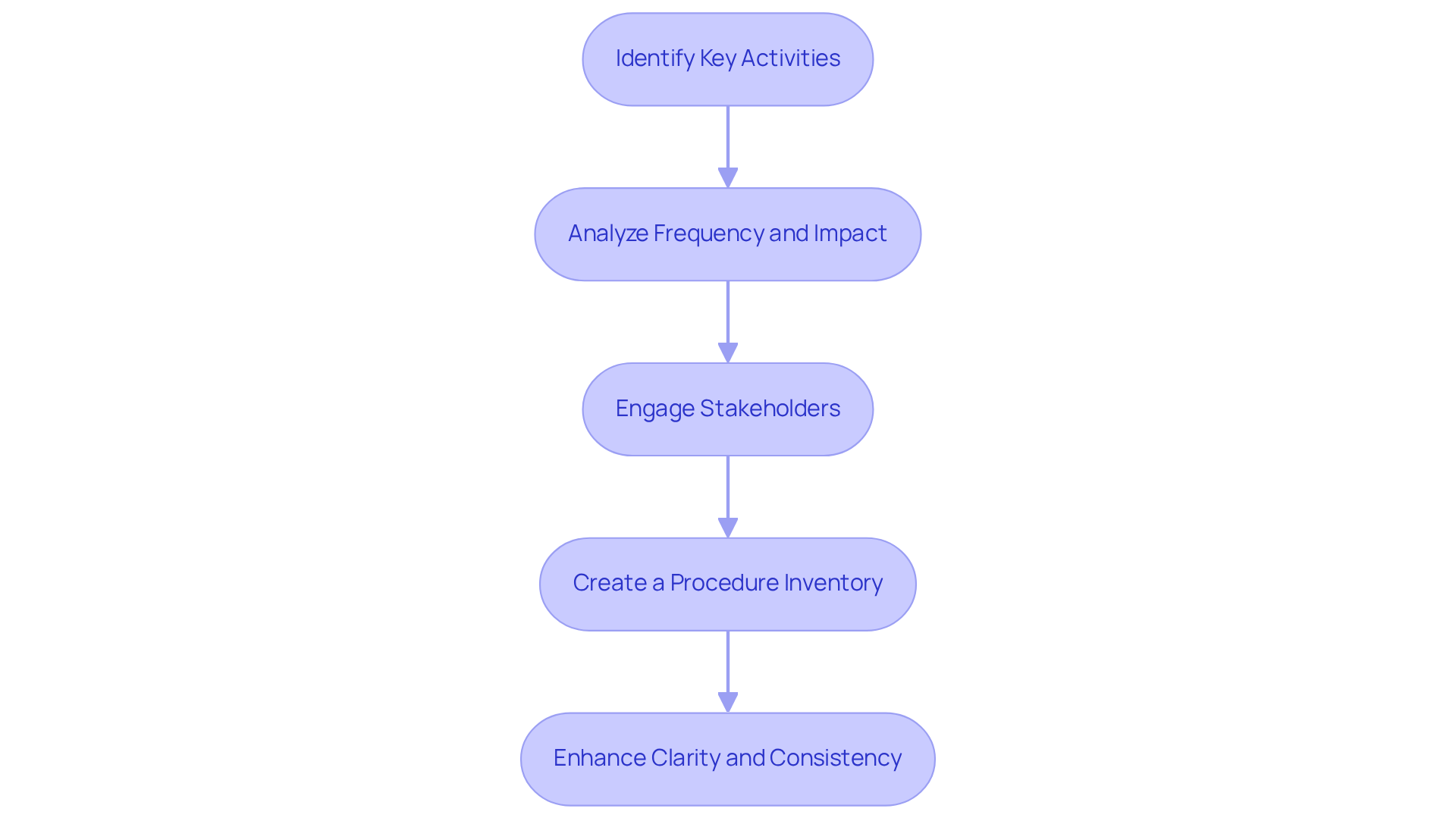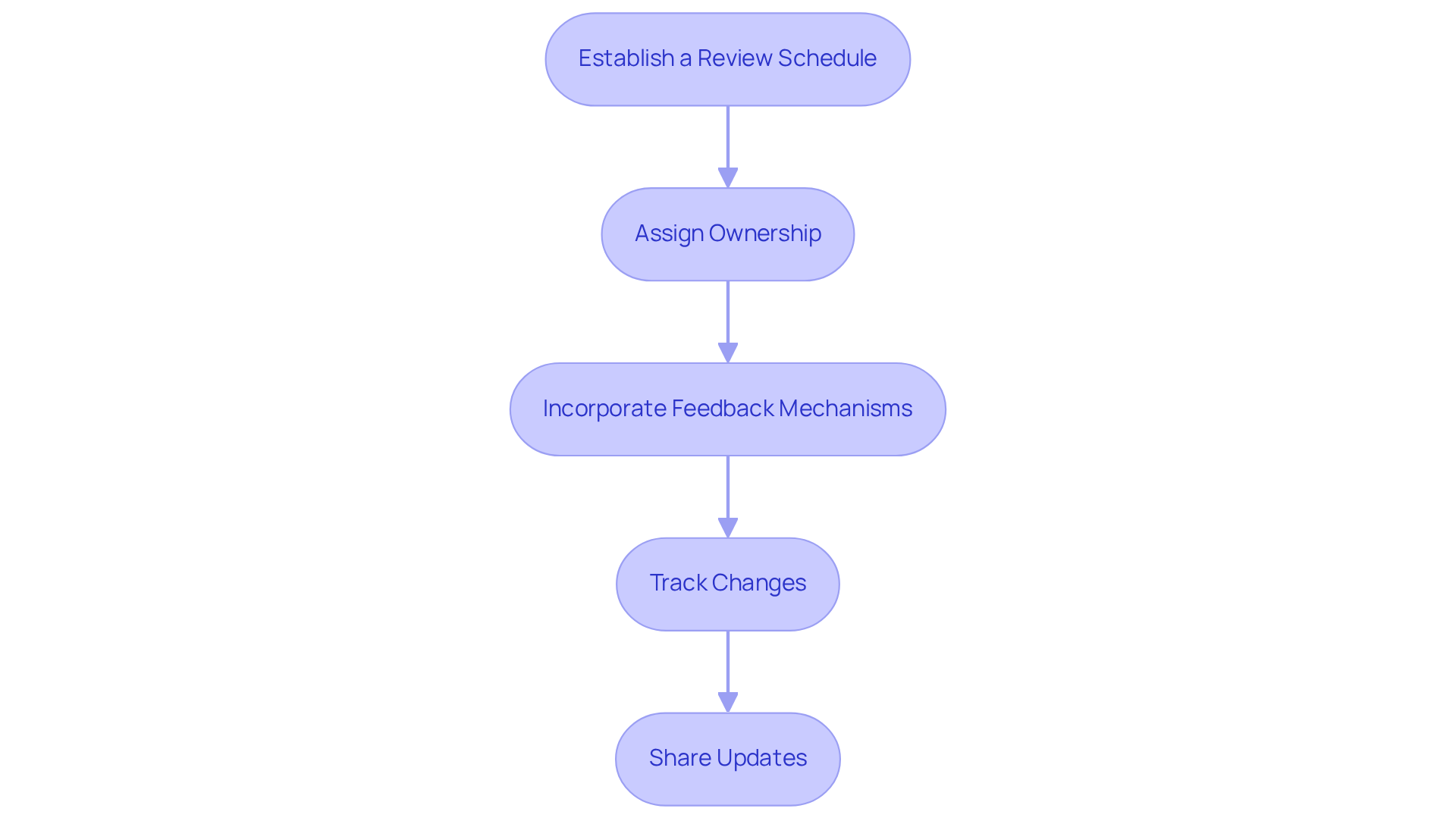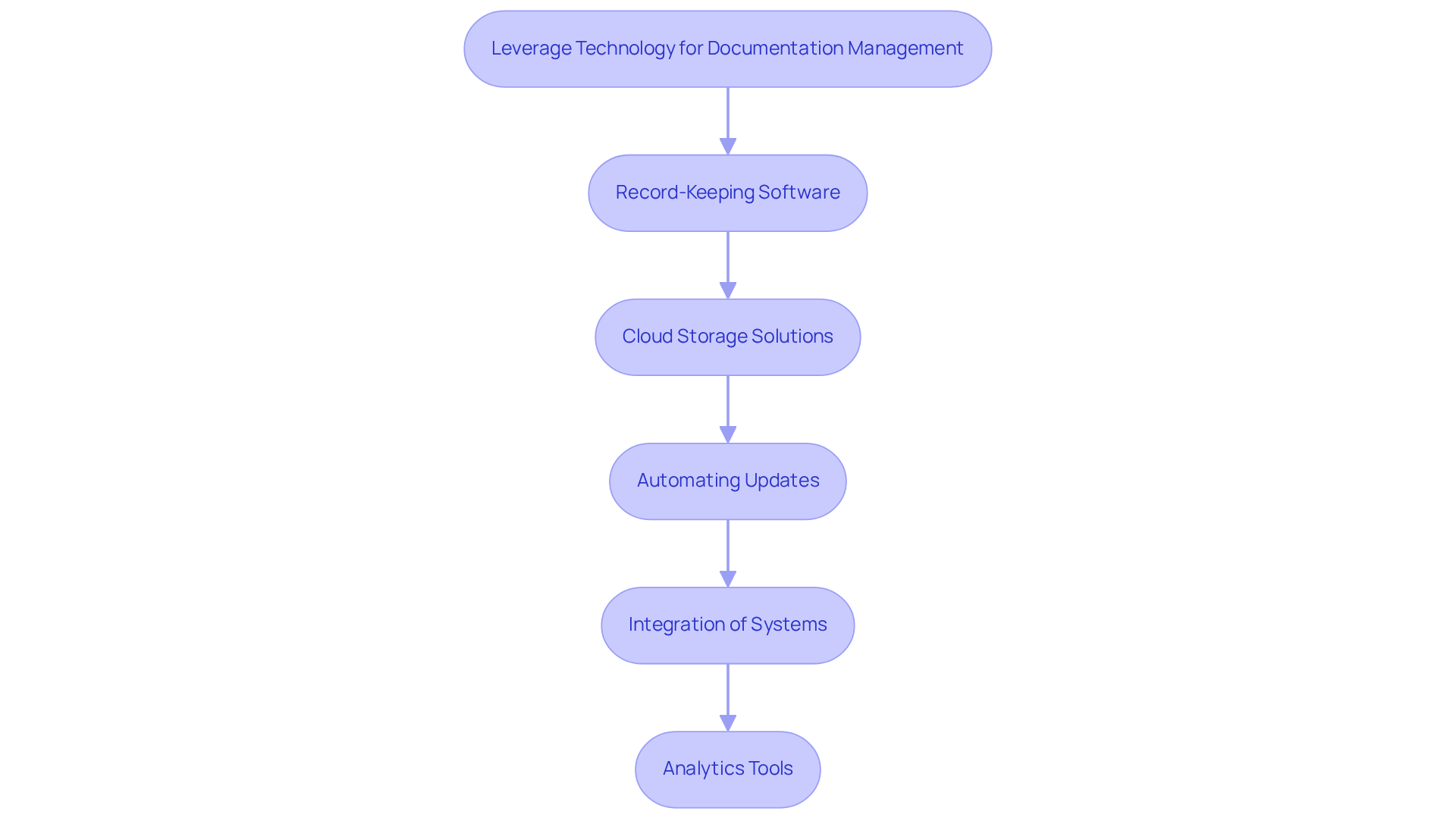
Overview
You might be wondering how organizations can really get a grip on their documentation. Well, the main focus of this article is all about mastering those repeated processes to make it happen! It highlights the importance of:
- Pinpointing key activities
- Getting stakeholders involved
- Using clear language and visuals
- Tapping into technology
The goal? To create a centralized, efficient documentation system that's not only relevant but also easily accessible over time. So, let’s dive into how you can make this work for you!
Key Highlights:
- Identify key activities by mapping core tasks that are repeated within the organisation.
- Analyse the frequency and impact of these activities to prioritise documentation efforts.
- Engage stakeholders to gain insights and foster ownership in the documentation process.
- Create a centralised procedure inventory categorised by department, frequency, and complexity.
- Use clear language in documentation to avoid confusion, ensuring accessibility for users.
- Incorporate visuals like flowcharts and diagrams to enhance understanding of complex processes.
- Standardise formats across documents to maintain a cohesive appearance and ease of navigation.
- Include step-by-step instructions to facilitate easy following of processes.
- Regularly review and revise documentation to keep it accurate and relevant to organisational needs.
- Leverage technology such as record-keeping software and cloud storage to improve documentation management.
- Automate updates and ensure integration with other systems to streamline workflows.
- Utilise analytics to monitor document usage and improve decision-making regarding documentation.
Introduction
Mastering the art of documentation management is key for organizations looking to boost efficiency and clarity in their operations. You might be wondering how to tackle this, right? By honing in on those repeated processes—those sequences of tasks that pop up regularly—businesses can really streamline their documentation practices. This way, important information is not only easy to find but also kept up-to-date.
But here’s the real question: how can organizations effectively define, document, and maintain these processes to encourage collaboration while keeping up with the ever-changing business world?
Now, let’s dive into some best practices and innovative strategies that can turn documentation management into a powerful asset for any organization.
Define and Understand Repeated Processes
Have you ever thought about how a repeated process consists of sequences of tasks that we run over and over again to achieve specific results? To really nail down these processes, organizations can follow a few simple steps:
- First up, you might want to Identify Key Activities. Start by mapping out the core activities that happen regularly in your organization. Think onboarding new employees, processing customer orders, or even those routine maintenance checks that keep everything running smoothly.
- Next, let’s Analyze Frequency and Impact. Take a moment to evaluate how often these activities occur and what kind of impact they have on your overall operations. If certain processes happen a lot and really boost productivity, those should be your top priority for documentation. For example, organizations that streamline their onboarding can cut training time by as much as 30%, which means new hires get integrated faster!
- Now, it’s time to Engage Stakeholders. Involve team members who regularly execute these processes to gather insights about the little nuances and variations that might be at play. Their input is crucial for creating accurate and thorough records. Plus, when you involve stakeholders, you not only improve the quality of your documentation but also help foster a sense of ownership and responsibility among your team.
- Then, you’ll want to Create a Procedure Inventory. Keep a centralized inventory of all the procedures you've identified, categorizing them by department, frequency, and complexity. This inventory will be a handy reference for future record-keeping efforts, ensuring that everything is easily accessible and up-to-date.
By clearly defining and understanding these recurring activities, organizations can set up a structured method for recording that enhances clarity and consistency across teams through a repeated process. With SowFlow's instant record-keeping solution, groups can whip up and tweak user guides with just a single command, making consistency and knowledge sharing a breeze. This not only boosts group efficiency but also ensures that your records remain relevant in today’s fast-paced business world.

Document Processes for Clarity and Consistency
To document processes effectively, you might be wondering what best practices should be followed in a repeated process by organizations. Let’s dive into some key points that can make a real difference:
- Use Clear Language: Documentation should be crafted in simple, straightforward language that’s easy to understand. Avoiding jargon and overly technical terms is crucial to prevent confusion among users. With the right platform, teams can produce clear and concise records effortlessly, ensuring that everyone gets the information they need without any hassle.
- Incorporate Visuals: Flowcharts, diagrams, and screenshots are invaluable tools for illustrating complex processes. Visual aids significantly enhance comprehension and retention, making information more accessible. The good news? You can easily incorporate visuals into your materials without even leaving your browser, simplifying the development of SOPs and training content.
- Standardize Formats: Establishing a consistent format across all records is essential. Think about uniform headings, bullet points, and numbering systems. These elements contribute to a cohesive appearance and make navigation a breeze. Thanks to a user-friendly interface, standardization becomes effortless, ensuring that all documents maintain a professional look and feel.
- Include step-by-step instructions: A repeated process should be broken down into clear, actionable steps. Each step needs to be concise and focused, allowing users to follow along easily and ensuring that nothing important is overlooked. With SowFlow's rapid record-keeping solution, teams can whip up comprehensive step-by-step guides in no time, boosting productivity and efficiency.
- Review and Revise: Regular evaluations of your written materials are necessary to keep things accurate and relevant. Proactively seeking input from users can help spot areas for improvement, ensuring that your materials evolve alongside organizational needs. SowFlow makes it simple to update and revise records, keeping everything relevant in a fast-paced business environment.
By prioritizing clarity and consistency in your records, organizations can create a dependable resource that empowers employees to perform their tasks efficiently and effectively. And hey, aiming for a Flesch-Kincaid Grade Level score of about 7.0 to 8.0 is a great way to ensure your material is easily digestible for a wide audience. So, why not integrate these methods, along with the innovative features of the platform, to avoid common pitfalls in record management?

Regularly Review and Update Documentation
To keep your documentation relevant and effective, you might be wondering how to do it? Well, organizations should definitely implement a repeated process of review and update, and SowFlow's innovative solutions can help you with that. Here’s how:
- Establish a Review Schedule: Set a timeline for reviewing your documentation—maybe quarterly or bi-annually, depending on how often your processes change. This system makes it super easy for you to create and manage schedules right within the platform, ensuring those updates happen on time.
- Assign Ownership: It’s a good idea to designate individuals or groups responsible for reviewing specific documents. With SowFlow, it’s a breeze since team members can easily access and revise records, making sure updates are swift and spot on. For instance, you could have someone in charge of the user guides, ensuring they reflect the latest processes.
- Incorporate Feedback Mechanisms: How about creating channels for users to share their thoughts on the documentation? SowFlow makes this easy with comment sections and feedback forms, allowing for continuous improvement based on what users really want. This kind of engagement can lead to more user-friendly guides that truly meet the group's needs.
- Track Changes: Don’t forget to maintain a version history for all your documents, noting when updates were made and what changes were implemented. This rapid record-keeping solution offers a transparent versioning system, helping everyone understand how processes have evolved and ensuring everyone is on the same page.
- Share Updates: It’s crucial to make sure all group members know about any changes to records. SowFlow supports this with integrated communication tools, making it simple to notify teams about updates through newsletters or internal platforms, which really fosters a culture of collaboration.
By utilizing a repeated process of consistently reviewing and updating records with SowFlow’s help, organizations can maintain a dynamic asset that grows alongside their workflows and supports operational efficiency. So, why not give it a try?

Leverage Technology for Efficient Process Management
You might be wondering how organizations can really amp up their documentation management processes with technology. Well, let’s dive into some impactful ways to do just that!
- First off, consider adopting record-keeping software. These specialized tools make it super easy to create, edit, and share files. Take SowFlow, for instance—it simplifies record-keeping and ensures everything stays consistent, cutting down on the time you’d otherwise spend on those manual updates.
- Next up, let’s talk about cloud storage solutions. By utilizing cloud-based systems, you can centralize files, making them accessible to your entire team from anywhere. This not only fosters collaboration but also helps tackle those pesky version control issues. Did you know that studies show 54% of cloud waste comes from a lack of visibility into costs? That just highlights how important effective management is!
- Now, how about automating updates? Exploring automation features in your content management tools can keep your information fresh. For example, automated reminders for review dates can ensure records get evaluated regularly, which boosts their relevance and accuracy.
- Also, integration is key! Make sure your record-keeping tools can connect seamlessly with other systems, like project management and CRM platforms. This integration streamlines workflows and cuts down on duplicated efforts, creating a more cohesive operational environment.
- And let’s not forget about analytics! Leveraging analytics tools allows you to monitor how materials are being used within your organization. Understanding user engagement can help you pinpoint which documents are most valuable and which ones might need a little TLC, ultimately leading to better decision-making.
By effectively leveraging these technologies, you can create a more efficient and organized repeated process for documentation management. This not only enhances productivity but also reduces operational chaos. So, what are you waiting for? Let’s get started on making your documentation process smoother!

Conclusion
Mastering the art of documentation management through repeated processes is crucial for organizations that want to boost efficiency and clarity. You might be wondering how this works. By systematically identifying, analyzing, and documenting key activities, businesses can create a solid framework that supports consistent operations and promotes teamwork. This structured approach not only streamlines workflows but also gives employees the tools they need to thrive.
Now, let’s dive into some best practices that really help with effective documentation management:
- Using clear language is a must to avoid any confusion.
- Incorporating visuals can enhance understanding.
- Standardizing formats keeps things consistent.
- Maintaining a regular review schedule helps keep those records fresh and relevant.
- Engaging stakeholders in the documentation process is key, as their insights lead to more accurate and useful resources.
- Leveraging technology like record-keeping software and cloud solutions makes everything more accessible and automated.
Ultimately, organizations that prioritize effective documentation management through mastering repeated processes are in a better spot to thrive in today’s competitive landscape. Embracing these strategies not only improves operational efficiency but also fosters a culture of continuous improvement and accountability. So, if you’re looking to refine your documentation practices, the time to act is now! Integrating these techniques can set the stage for a more organized and productive future.
Frequently Asked Questions
What is a repeated process in an organization?
A repeated process consists of sequences of tasks that are run over and over again to achieve specific results within an organization.
What are the steps to define and understand repeated processes?
The steps include identifying key activities, analyzing frequency and impact, engaging stakeholders, and creating a procedure inventory.
How can organizations identify key activities?
Organizations can identify key activities by mapping out the core activities that happen regularly, such as onboarding new employees, processing customer orders, or conducting routine maintenance checks.
Why is it important to analyze the frequency and impact of activities?
Analyzing frequency and impact helps organizations prioritize which processes to document, especially those that occur frequently and significantly boost productivity.
How can engaging stakeholders improve the documentation process?
Involving team members who regularly execute processes provides insights into nuances and variations, enhancing the accuracy and thoroughness of the documentation while fostering a sense of ownership among the team.
What is a procedure inventory, and why is it useful?
A procedure inventory is a centralized record of all identified procedures, categorized by department, frequency, and complexity. It serves as a handy reference for future record-keeping efforts, ensuring accessibility and up-to-date information.
How does SowFlow's record-keeping solution assist organizations?
SowFlow's instant record-keeping solution allows groups to create and modify user guides quickly, promoting consistency and knowledge sharing, which boosts group efficiency and keeps records relevant in a fast-paced business environment.
👍
What others are liking
5 Steps to outline your ideal documentation structure
5 MINS READ
Where to start the your journey of mapping out your ideal documentation structure, aligning it with the very heartbeat of your organization?
Defining a winning level of detail in your process
3 MINS READ
What is too much detail, and what is too little? This article described in that winning level detail about what detail is enough.





